dIFFERENTIATIoN STRATEgY FoR CoNSULTANcIES
Do your clients say they’ve never come across a consultancy like yours? Do prospects flock to you because of your expertise? Do you have a unique way of doing things that delivers exceptional results and helps sell your services to buyers?
If you answered ‘yes’ to all these questions, get in touch — we want to meet you! If you’ve struggled to relate, you’re likely a cookie-cutter consultancy. That means your consultancy is failing to differentiate itself from the average consultancy and is at risk of fading into the background.
But don’t panic! This is where creating a focused differentiation strategy comes into play. With a tightly defined strategy that makes your consultancy incomparable, you can go from this:

To this:

In other words, your consultancy becomes impossible to pigeonhole amongst the cacophony of competitors.
In this guide, we’re looking at the importance of differentiation in an overpopulated industry and breaking down how to build a successful differentiation strategy that wins you eyeballs (and business) with proven tips and tricks. Let’s get started by defining precisely what differentiation means for consultancies.
What is a 'differentiation strategy'?
A successful differentiation strategy will give you a competitive advantage over rival consultancies, which leads to a greater market share.
While positioning is all about how your clients perceive you, differentiation centres around really owning a unique selling proposition — and delivering it much better than your competitors. From outputs to experiences, you can differentiate your consultancies in dozens of ways.
Put simply, differentiation is the distance between you and your competitors. By becoming known for doing one thing really well, you can attract the attention of the right corporate buyers. Greater market share = more clients = more wins = more growth.
Understanding the 'why': the need for differentiation
So, why does any of this matter? Surely, if your intentions are good and you’re putting in hard work, the buyers will come. Right? If only it were that simple.

As we’ve established, being effectively differentiated can win you more clients, better clients, dominance in your niche and more significant growth. On the flip side, failing to distinguish your consultancy from all the others will only get you:
- Scrapping for sales. Great differentiation makes the sale for you. When you’re just one in a million (and not in a good way), you’ll have to put in much more effort to get sales over the line.
- Missed opportunities. Why should a client work with you if there’s no real difference between you and the next highest-ranking search result on Google?
- Low conversions. Even if you get to pitch, there’s no guarantee the buyer will remember you. If they can’t remember which potential suitor you are, you’ve already lost.
- Competitive on prices. If you’re winning business only because you’re cheap… Well, we have nothing good to say about that.
With ever-changing market trends and copy-cat consultancies taking away market share, this is about more than staying competitive; it's about survival in a digitally connected world. It’s about using differentiation as a strategic tool to stay relevant to clients obsessed with innovation, agility and specialised expertise.
You can see this as an impossible challenge or an opportunity to capture a unique position in the market. This is why, now more than ever, differentiating your consultancy needs to be at the top of your to-do list if you want to drive business growth. The benefits of standing out can’t be argued with. So we don’t recommend you try.
Analysing the 'how': Strategies for effective differentiation
Let’s get into the good stuff: how to differentiate your consultancy. Here are three of the most vital components of an effective differentiation strategy.
Crafting and communicating your unique mechanism
One of the best ways to differentiate your consultancy is with a unique output that sets you apart from the competition, such as a process, tool or approach. At Total Growth Ownership, we call this the ‘unique mechanism,’ our name for a method or process that creatively showcases what your consultancy does. Here’s a quick overview of how to create a unique value proposition in consulting:
- Step 1: Give your unique mechanism an identity. Your unique mechanism can take many forms, from a practice you follow every day to a core process. The key is to make this process visible, memorable and unique by naming it and giving each step a title.
- Step 2: Create an engaging visual. Make your unique mechanism memorable by turning it into a visually digestible process that aligns with your brand guidelines.
- Step 3: Add it to your Services or About page. Your unique mechanism will form a fundamental part of your ‘how we work’ story. Don’t save it for your presentations; place it front and centre on your website.
- Step 4: Post a walkthrough to LinkedIn. Record a video walkthrough of your unique mechanism and make it a featured post on LinkedIn. This will mean it’s the first thing prospects see when they visit your LinkedIn page to learn more and makes it easily shareable.
Here’s a real-world example. We supported Khiliad in developing a unique mechanism titled Precision Driven Development. With a linear and a cyclical element, this showcases their method of delivery in a unique, neatly packaged way that allows prospects to understand how they work at a glance.
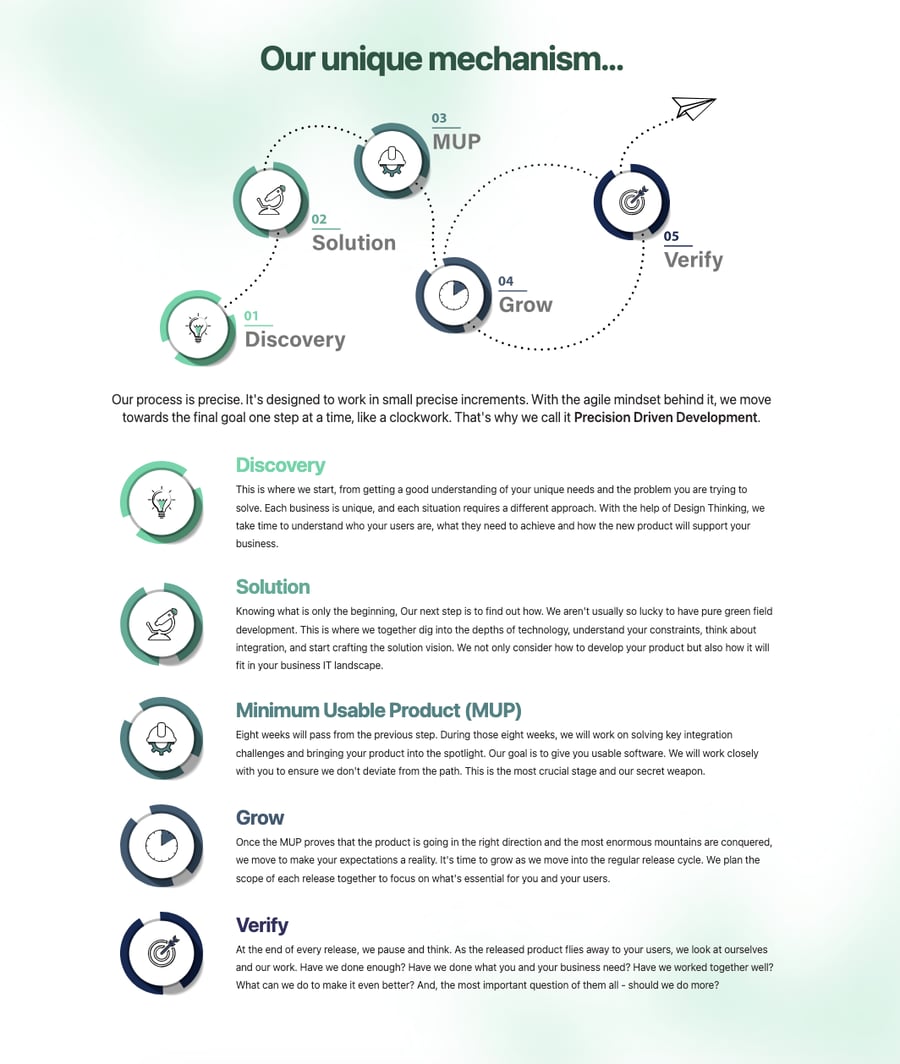
Leveraging technology and innovation for competitive advantage in consultancy
You have to innovate continuously. This isn’t negotiable. With an AI revolution on the horizon, you need to refresh your methodologies, explore undiscovered opportunities and stay on the cutting edge of technological disruption. Yes, this may mean cannibalising existing business models in favour of new ones, but that's how the cookie crumbles. If you want not only to survive but thrive, you must be willing to reinvent yourself and wave goodbye to antiquated frameworks. They’ll only hold you back.
Instead, see this as an opportunity to innovate, differentiate and reinforce your value. Become obsessed with the evolution of your industry and how technology can help you progress your offerings. Can you leverage AI to handle repetitive tasks and free up consultants to focus on delivering real value to clients? Are there new data analytics tools you can use to uncover valuable insights? Balancing AI efficiency with human ingenuity is a new and exciting way to differentiate your consultancy and retain clients as technology continues to dominate.
Building a brand that resonates with corporate buyers
Many people incorrectly view consulting as a cold, impersonal industry. The truth is it thrives on human connection. Building a brand that resonates with buyers means aligning your strategy with their challenges and needs. Not every potential client will align with your positioning, but that’s ok. In fact, that’s precisely what you want.
You can build a resonant, value-led brand by:
- Speaking out about your causes. Every consultancy has something it ardently stands for or against. Clients want to know what this is, allowing them to qualify or disqualify themselves accordingly.
- Utilising messaging and written elements. Your messaging is critical to your brand and will be communicated via written elements like website copy or marketing materials. Your message must make sense to your clients by staying true to your values; for example, innovative consultancies embody an open-minded attitude.
- Reframing your consultancy market positioning. Your positioning is a key component of your brand. It should reflect on clients' emotional experiences and build resonance by recognising the buyer’s pace and where they are in their journey.
The dos and don’ts of effective differentiation
There are many ways to differentiate your consultancy. Luckily, you don’t need to differentiate in lots of different ways; just one will do. Let’s look at three great and two not-so-great examples of key differentiators for consultancies.
Do differentiate on:
- Your niche or sector. You want to become the go-to expert in a specific niche. By presenting your consultancy as able to anticipate future challenges in the market, you’ll become seen as an indispensable resource.
Remember, niching can be risky, as it assumes the market will remain stable for the foreseeable future. Imagine if you’d niched in the travel industry at the beginning of 2020! Things would look very different now. We’re not suggesting you put yourself in the smallest box you can find; instead, niching is about taking a targeted and focused approach to segmentation at a persona level.
Take Stratforce Consulting. Their website copy explicitly clarifies who they work with, presenting them as a thought leader in their niche. At the same time, prospects can either recognise themselves in the statement or disqualify themselves, effectively filtering inbound leads.
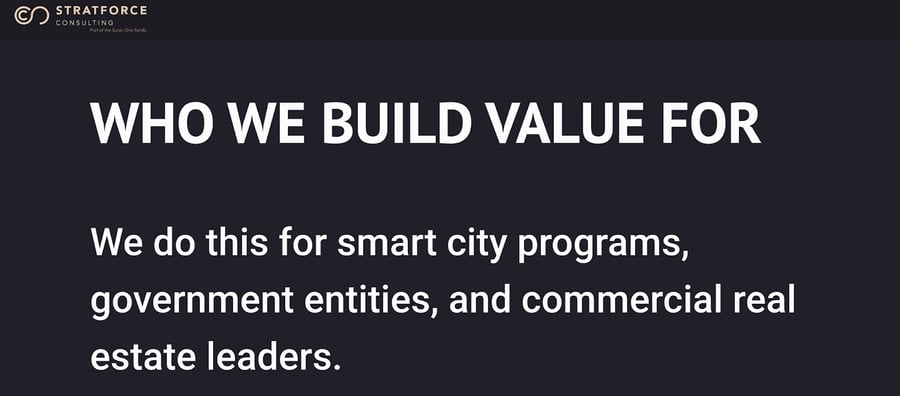
- Your quantifiable results. The proof of the pudding really is in the eating. Clients want to see tangible outcomes you’ve achieved for similar businesses. This means publishing quantifiable, data-backed results — not just anecdotal case studies — proving your expertise and building trust. Having the ability to speak to specific game-changing wins can set you apart.
Here's another great example. Reson8 shouts about their quantifiable results — delivering an 8 to 1 ROI for clients — as soon as you land on their homepage. As no one else in the space makes such bold claims, Reson8 immediately stands out from the competition.
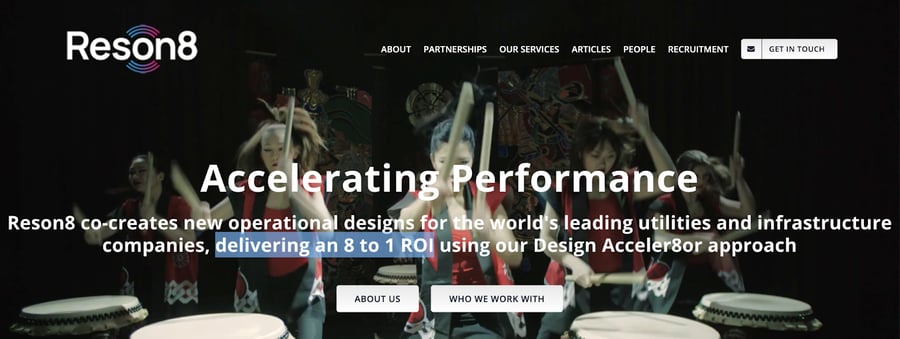
- Your unique mechanism. Yes, we’re banging on about unique mechanisms again. Because they WORK. Be clear on what it is, make it look and sound good, and shout about it whenever possible.
NextWave reinvented their entire internal process after creating a unique mechanism. Now, it's the foundation of everything that they do.
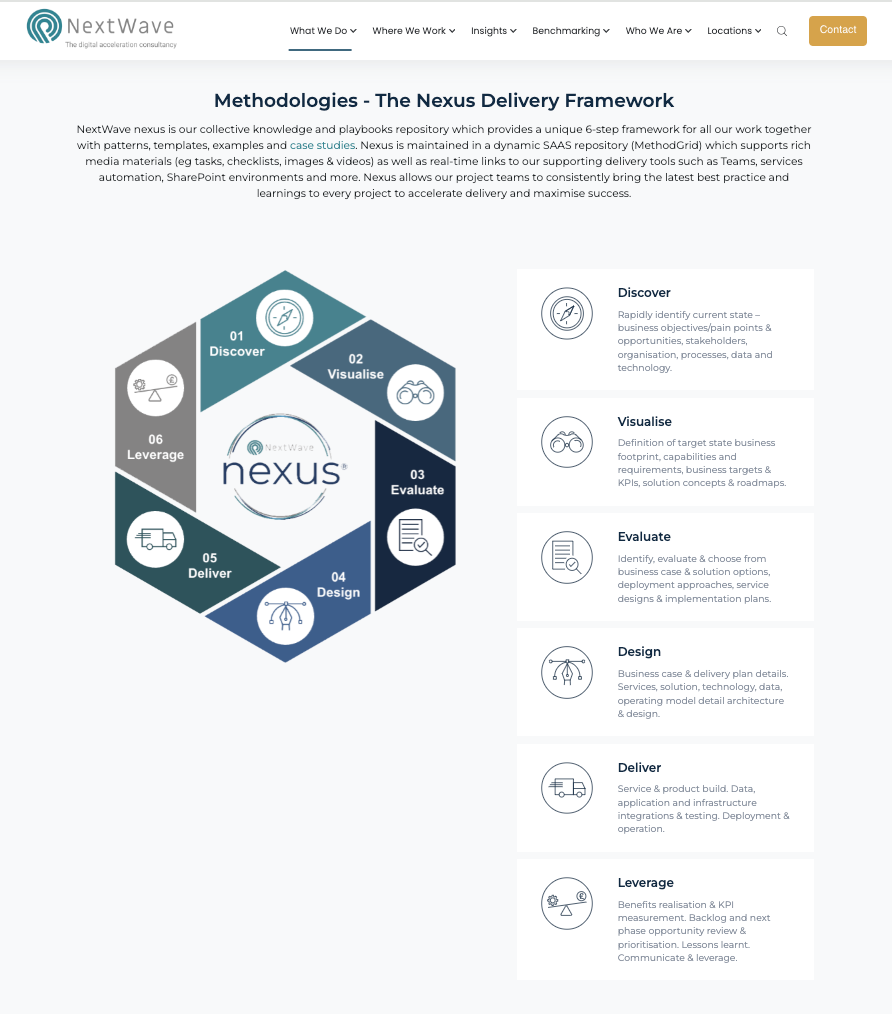
And Waymark had fun naming their XITE Framework, which led to a redesign of all their processes.
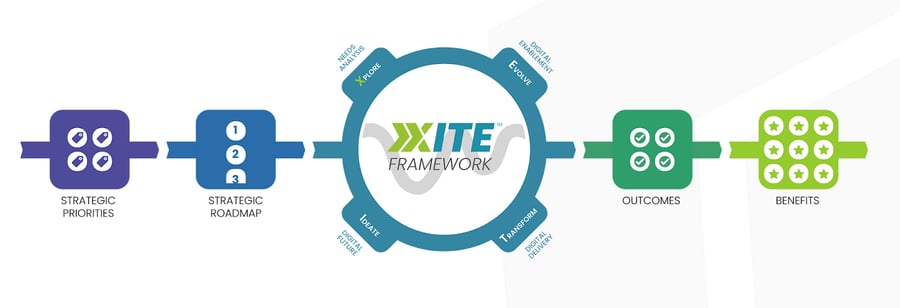
Make sure you definitely don’t, under any circumstances, differentiate on:
- Price. Being competitive on price will win you the race to the bottom, as clients choose you because you’re cheap, not for the benefits you offer. While you might win business in the short term, this strategy will undermine your consultancy’s value and prevent you from achieving your desired growth.
- The number of awards you’ve won. Awards are a testament to your achievements, but they’re just that: a trophy case of industry recognition. Clients want to know how you’ll solve their specific problems and the value you offer in the present.
Exploring the 'when': timing your efforts
We’re in the midst of a bun fight for the best points of differentiation. Failing to protect your differentiators is akin to sending them gift wrapped to any one of the copycat consultancies looking for an in. So, should you wait until the ‘right time’ to capitalise on your difference or take action right now? Here’s how to time your differentiation efforts effectively.
Assess market conditions and competitor movements
When planning your differentiation efforts, you can’t just throw something at the wall and hope it sticks. Understanding market conditions and your closest competitors' moves is essential to timing your efforts.
Wait too long to own your strategy, and a competitor may beat you to the finish line. Jump on an emerging trend without adequate preparation, and you might find it sinks as fast as it surfaced.
By keeping a close eye on industry trends and your competitors’ strategies, you can identify unmet needs and capitalise on competitive advantages. In the long term, this will help you maintain a differentiation strategy that is relevant and compelling.
Align differentiation efforts with your business growth stages
Aligning your efforts with each stage of your growth plan is like planting seeds at just the right time of the year rather than doing everything at once.
During the early stages, focus on laying a strong foundation by identifying what sets you apart and testing this identity with current clients. As your business grows, you can lean further into these differentiators and refine them based on client feedback and market changes.
This strategic approach evolves your USPs as you scale. This will ensure they resonate deeply with your ideal corporate buyer and help you stay ahead of the competition.
Find opportune moments for rebranding and repositioning
Finding the right time to reposition isn’t just about adapting your strategy to changing market needs but matching the pace of the buyer. In fact, you want to stay a little bit ahead, anticipating their challenges and reacting based on where they are on the journey.
The main thing to remember here is that the buyer doesn’t want to be where they are right now. Like you, they’re ambitious and hungry to reach the next level. Your consultancy should speak to this aspiration, not as an over-enthusiastic TV evangelist (there is such a thing as too much hyperbole, after all) but as a confidence-building hype man.
Identifying the 'who': Knowing your audience and competitors
One of the key components of successful differentiation is crafting a unique identity that resonates with and is easily recognisable by your target audience. So, who are these people? Let’s talk about finding and engaging with your ideal corporate buyer.
Segment the corporate buyer market
Segmenting the corporate buyer market means dividing it into smaller, more easily defined segments. By understanding each segment’s needs, preferences and pain points, you can decide which will align closest to your consultancy’s beliefs and deliver a strategy that will appeal to this segment.
Failing to match your message to your segment would be a bit like putting tonnes of effort into whipping up a delicious steak and setting it in front of a vegan. So, make sure to do your research first.
Understand your position in the market with competitor analysis
When it comes to successful differentiation, knowledge. Is. Power.

Competitor analysis can help you understand your position in the market, uncovering what stakes other consultancies have already claimed and where opportunities can be leveraged. Think of the consultancy sector as the globe and you as the excitable young adventurer looking for an unclaimed piece of land to stick your flag into.
Competitor analysis includes reviewing your competitor’s strategies and performing a SWOT analysis, uncovering their strengths, weaknesses, opportunities and threats. You may find your competitors are underperforming in a certain area or uncover an underserved niche, leaving them open for the taking.
This process isn’t about taking inspiration from competitors. The goal is to understand what the ‘baseline language’ used sounds like so you can rise above it. After all, you can’t differentiate without first knowing what you need to differentiate from!
Create a tailored message that resonates with your ideal buyer
If you want to get the right eyes on your consultancy, you want to craft a message that resonates with your ideal buyer. By weaving a narrative that resonates with your ideal buyer’s pain points and values, you can maximise your consultancy's visibility and attract clients who truly appreciate its unique value. Your messaging becomes a loudspeaker capable of lasing in on your ‘best fit’ clients.
If you’re concerned that putting all your eggs in one basket can be a risky play, try keeping your message flexible enough to be applied to multiple situations. This will help you avoid being pigeonholed in the future.
Determining the 'what': Elements of differentiation for consultancies
Here’s the fun part: deciding what elements of differentiation you’ll use to stand out from the crowd. No matter what services you offer, standing out means delivering a 360-degree experience that provides value to your clients at every touchpoint. Here are points for consideration when determining your ‘what’.
Service offerings: Specialisation vs full-service solutions
To niche or not to niche? There are merits to both approaches. Delivering full-service solutions will help you remain flexible and competitive in a dynamic market but will also limit your opportunities for differentiation. On the other hand, honing in on a niche may feel limiting, but specialisation allows you to offer deep, unmatched expertise.
You can avoid all these pitfalls by selecting an underserved niche that buyers will value. AKA, a goldmine of untapped potential. Just be prepared to flex this offering if the market tides change.
Thought leadership and content strategy as differentiation tools
Sorry to break it to you, but if you’ve not been shouting about your team’s expertise all over your social media and email marketing, you’ve missed out on hundreds of opportunities to connect with buyers.
Demonstrate your consultancy's depth of knowledge and unique approaches via LinkedIn articles, webinars, free ebooks, email marketing and more. By sharing your unique perspective, you will position your consultancy as a thought leader and as the go-to resource in your niche. There’s no quicker and more efficient way to get your message across than by wielding content strategy as a differentiation tool.
Customer experience and relationship management
If you’re not committed to delivering an incredible customer experience, you might as well forget everything else you’ve learnt from this guide. You can wine and dine your clients and promise them the world, but if they don’t like spending time with you, you’re getting kicked to the curb.
Your unique message should permeate all aspects of your marketing and sales experience, from when they first discover your consultancy to their eventual off-boarding. Every interaction a client has with your agency should be meaningful, resonate with buyers and reflect your values. This fosters loyalty and reinforces your brand image.
Position activation: Practical steps and considerations
We’re probably teaching Grandma how to suck eggs here, but consistency is key. Your Positioning Activation (what we call differentiation implementation at Total Growth Ownership) ensures your message remains consistent across all channels, comms and assets, whether they support marketing, sales or delivery. Here’s how to do it properly.
Find inner peace. Um, we mean internal alignment.
When we say you need to be consistent across every touchpoint, we mean every touchpoint. Including interactions with your team itself. Ensuring your team embodies your differentiation will create a consistent experience for potential and future clients any time they interact with your consultancy. Support internal alignment through:
- Marketing materials. By creating a consistent and recognisable identity that’s reflected in your team’s LinkedIn profiles, email signatures and more, you establish true differentiation.
- Training. Training ensures every team member, from consultants to office managers, can articulate the consultancy’s differentiation.
Cast a wider net for feedback
Never, ever become complacent about your messaging. This means avoiding relying on internal feedback loops, which are biased. Asking your team what you could do better is like asking a besotted parent to point out their child’s flaws. The feedback will shy away from uncovering any uncomfortable truths. And unfortunately, uncomfortable truths are what help us grow.

Casting a wider net for feedback, including gathering responses from clients and experts, will hold you accountable for relooking at your differentiation when it no longer serves you or your clients. Fail to do so, and you might as well deliver your best clients to your competitors on a velvet cushion.
Measuring success
There’s magic to be found in measurement. Differentiation isn’t a one-time event, which means you need to make optimisations — and even wipe the slate clean — from time to time. Running retrospectives and capturing hard evidence is no easy task, but doing so will help you make informed decisions that strengthen your competitive edge — and prove your value to clients.
Here are five clear, quantifiable KPIs and metrics you can use to effectively evaluate your differentiation efforts.
- Customer satisfaction scores. High scores suggest your differentiation brings in the right buyers, while low scores suggest room for improvement.
- Market share growth. If you stand out from competitors, you will capture more of the market. An increase in market share indicates your strategy is working.
- Client retention rates. A strategy that aligns with your clients’ values will inspire long-term loyalty, leading to high retention rates.
- New client acquisition costs. How much does each new client acquisition cost the consultancy? When your strategy does the talking for you, your acquisition costs will be negligible.
- Employee engagement and retention. When the business is doing well and has a clear direction, this inspires employee engagement and loyalty. As your employees are your most valuable ambassadors alongside your clients, this is important to nurture.
Future-proofing your differentiation strategy
So, what’s next? The consulting world is subject to intense fluctuations, so you need to future-proof your differentiation strategy, ensuring it stays relevant for as long as possible.
Anticipating market trends and buyer needs
Maintaining a competitive edge means continuously innovating and adapting your strategy to meet market needs. You can never take your finger off the pulse. The moment you do, you’ll lose track of what’s happening in the market and struggle to serve your customers.
Keeping one eye on what you’ll be facing in the future of consulting helps you anticipate emerging trends and evolve your strategies and offerings accordingly. This goes a long way to positioning your consultancy as ready to address future challenges.
Continuous innovation and adaptability as key drivers
If you want your strategy to be sustainable, you need to prioritise continuous innovation and adaptability in your team. This means fostering an environment that encourages your team to challenge the status quo, share ideas and remain open to new technologies and methodologies. With the AI revolution coming for us, a culture of innovation will ensure your consultancy remains agile, supporting future growth.
Building a sustainable and evolving differentiation strategy
Innovation. Agility. Sustainability. All values you should embed into your consultancy’s DNA. By remaining flexible, it’ll be possible to adapt your differentiation strategy over time to meet your buyers’ ever-changing needs and challenges. On the flip side, refusing to flex will see your consultancy’s approach become outdated pretty quickly.
So, what does that mean in practice? We advise regularly revisiting and revising your USPs in response to market changes, protecting your position as a leader in your field. Lead the charge and prove you provide value others can’t replicate, and your competitors will be eating dust.
The path forward for consultancy leaders
Now that’s all said and done, we’ll leave you with our key takeaways. Print this page out, make it your computer background, tattoo this paragraph on your hand - do whatever it takes to remember these five points.
- Failing to differentiate is failing, full stop. Taking measures to differentiate your consultancy is a non-negotiable. The process may feel overwhelming at first, so start small. Ask yourself what’s unique about your offering, experience or clients, and go from there.
- Place your service offerings front and centre. Fancy messaging is great, but if there’s no substance behind it, you’ll fall flat on your face. Work with your clients and prospects to build solutions that meet real needs.
- Leverage thought leadership. Put your clever brain to work and establish your firm as a thought leader. Sharing your knowledge and experience via blogs, white papers or webinars will showcase your expertise and strengthen your market position.
- Put the customer first. The customer may not always be right, but they should be your priority. Differentiation is as much about what you say you do as what you actually do, so delivering a positive, memorable customer experience is critical.
- Be prepared to innovate. Going back to the drawing board may be disheartening, but it’s essential to ensure you’re keeping afloat in the choppy seas of consulting. Stay one step ahead by revising your strategies and processes in response to market developments.
Continue your MEHducation journey
While we’ve split (almost) all our secrets on differentiation strategy for consultancies, there’s always more to discover. Take your learning journey to the next level with industry reports, free training and more.
- Free training: How to break through any consultancy growth ceiling. Our founder, Matt Hodkinson, teaches you how to guarantee a consistent and predictable flow of new clients in 17 minutes.
- 60 ways to market your consultancy guide. AKA, 60 easy marketing wins, from quick tricks to actionable conversion strategies, served up on a shiny gold platter. For FREE.
- The MEHscapology book. In this positioning page-turner, we give you a step-by-step formula for transforming your market presence and core business language. You’ll learn the true cost of bad positioning, the importance of differentiation and how language drives audience perception.
- The most differentiated consulting firms. Ever wondered which consulting firms have the most differentiated offerings in the market? This article reveals all.
- Consulting Success: The Proven Guide to Start, Run and Grow a Successful Consulting Business. Michael Zipursky’s book is packed with value, guiding readers on how to start, run and grow a successful consulting business.
- The Win Without Pitching Manifesto. In Blair Enns’ book, you’ll discover 12 steps creative business owners can take to distance themselves from their competition.
- Eat Their Lunch. This must-read book reveals how to win customers away from your competition.
- How Consultancies Can Get Started With Value Proposition Design. In this article, The Visibility Authority discuss how to master the art of designing a value proposition.
.png?width=80&height=80&name=Untitled%20design%20(8).png)
